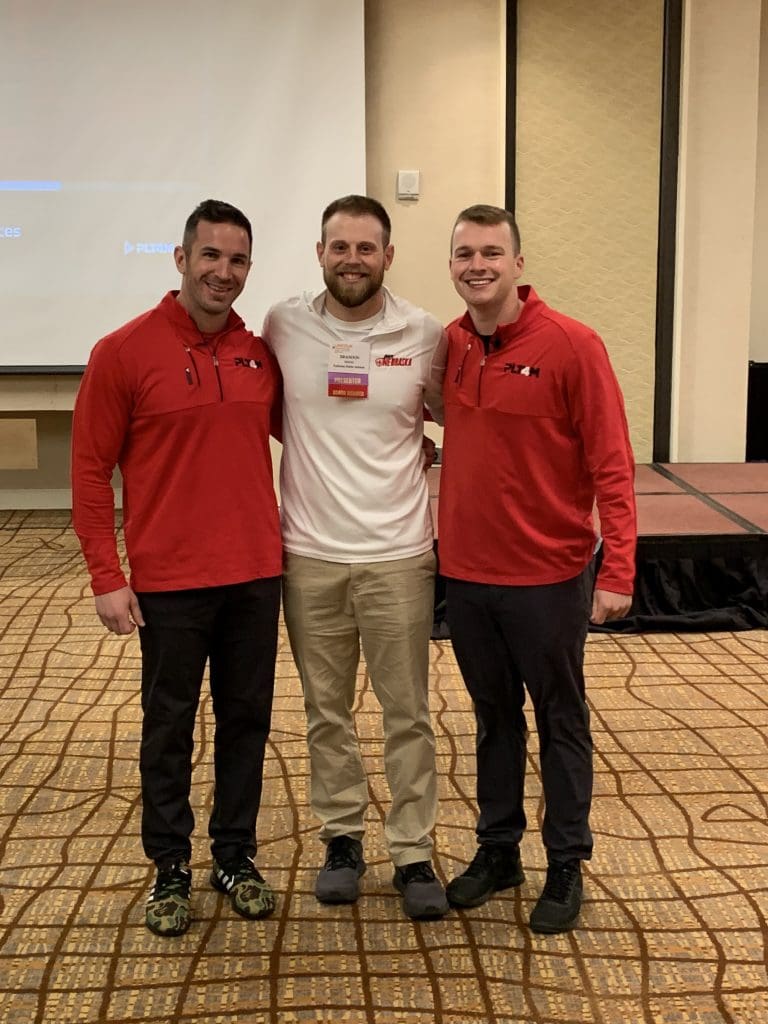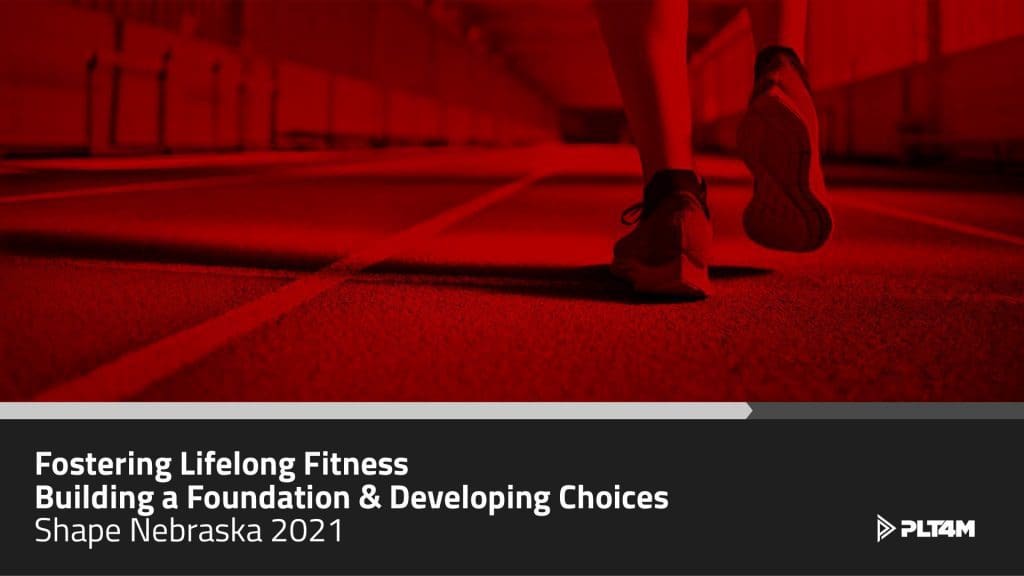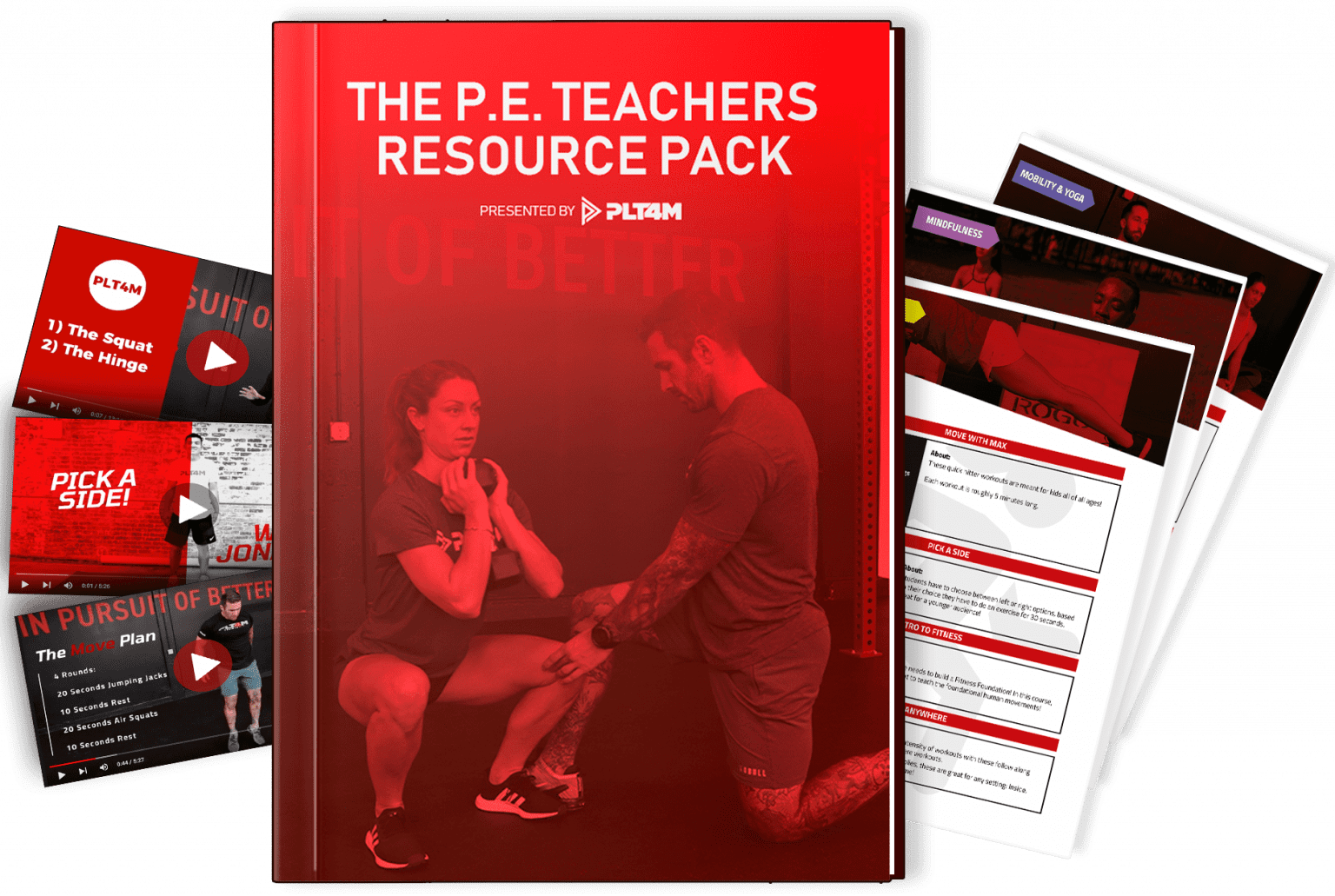“The mission of SHAPE Nebraska is to promote healthy lifestyles through leadership, professional development and advocacy in the areas of health, physical education, recreation and dance.” – Shape Nebraska Mission Statement
Like many state groups, Shape Nebraska hosts a yearly conference that brings together educators from across the region to share ideas and best practices. This year, PLT4M was invited to present and close out the conference with a final presentation and seminar for the entire group.
Fostering Lifelong Fitness
As we prepared for the conference, we found ourselves looking to send a message of fostering lifelong fitness. In doing so, two clear topics/areas of interest emerged:
- Teaching Foundational Human Movements
- Providing Choices & Options
How do these two topics intersect in the world of PE? We broke it down.
Teaching Foundational Human Movements In Physical Education
The staple of PLT4M’s very existence. Every good fitness journey starts with students establishing a strong foundation in basic human movement patterns.
- Squat
- Lunge
- Hinge
- Press
- Pull
- Walk/Run/Carry
- Jump
Every student should be able to walk away from physical education having an understanding and grasp of these movements and how to perform them well.
What better way to hammer home a conference than returning to the basics and covering a few of these movements and how to teach them in great detail?
Providing Choices and Options in Physical Education
The ever growing emphasis of physical education programs. Every good fitness journey is centered around students experiencing different options that will lead to them having an abundance of lifelong fitness choices.
- Fitness
- Yoga
- Dance
- Weightlifting
- Barre
- Pilates
- Sports & Games
The more exposure students have, the more options they have to choose from that will allow them to lead a healthy and active lifestyle. How will a student know what they like or don’t like when it comes to physical activity, if they have not gotten the chance to try it and a safe and nurturing environment like PE?
The Balancing Act
Rather than spend our time focusing on only one of the topics, we chose to address the unique tension between the two throughout PE. PE teachers are in a constant battle to keep students attention while educating them so that they have skills to be fit for life. How one goes about doing that is an ever changing balancing act, that lives somewhere between building a strong foundation and developing choices.
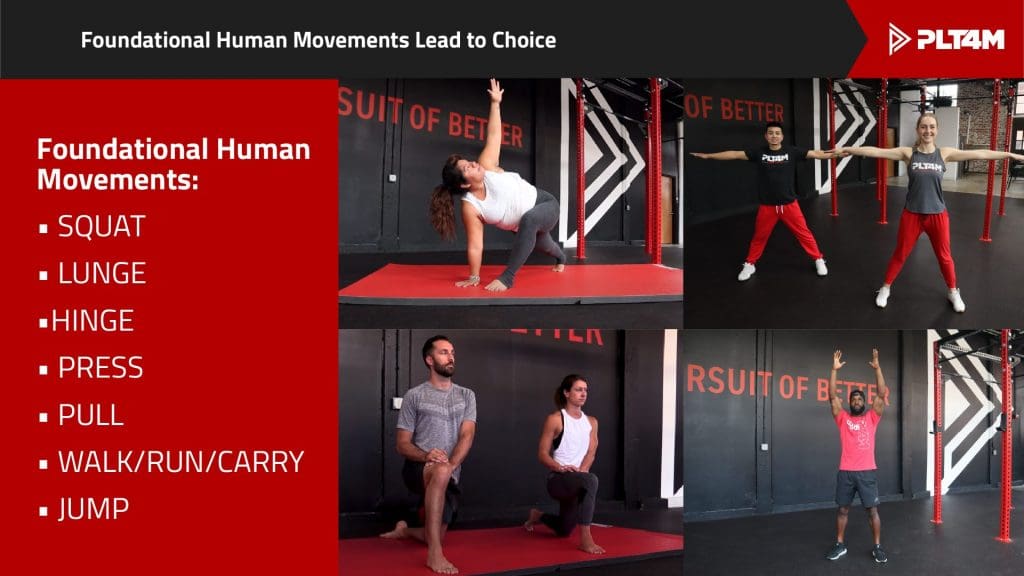
Fostering Lifelong Fitness: Building A Foundation & Developing Choices
Much like a great physical education curriculum, our presentation aimed to strike a balance between foundation and fundamentals and choice and exposure. Here is how we did it.
Step 1: Know Your Audience
PE has a lot to cover!
PE and health teachers are often tasked to be a jack of all trades. And the list of topics, units, and subjects that teachers are asked to cover just continues to build up. From yoga, weightlifting, team-sports, sex education, nutrition and more, the list gets longer each year.
Coming out of covid even, social-emotional learning became the next best topic that PE teachers had to be sure to cover throughout their curriculum.
So when PE teachers hear the word choice, many of their brains start to race because there is only so much time in a semester to cover all of these different things!
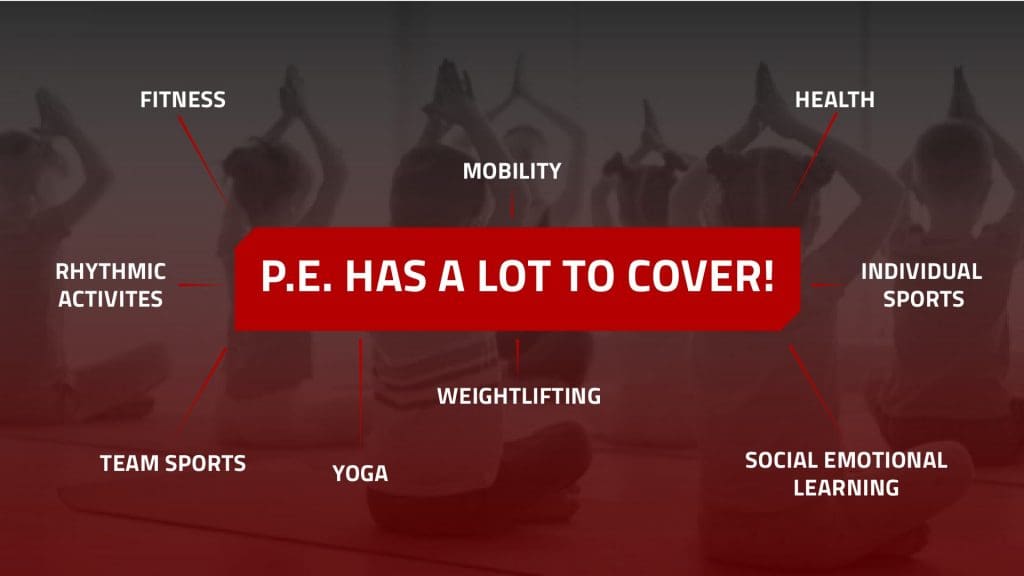
Step 2: Address Why Choice Matters So Much Anyways?
Seriously, do other subjects have to worry about choice as much as PE does?
When someone in English class doesn’t like the book assigned, they just don’t read or pretend to read.
When someone in PE doesn’t want to do a physical activity they just don’t do it at all.
There is a unique challenge in PE that other subjects don’t have to worry about. Sweat and insecurity are powerful detractors, and can lead to many students choosing not to participate at all. Their brains say, ‘Nope, no way!’
The alternative is giving students choices so that they feel as if they are in control, and therefore have more interest in participating. Therefore choice can become the reason a student does or does not in PE, but also in life.
Step 3: Define Choice
“Student choice is more than simply picking a task. It is about owning the entire learning process.” – Dr. John Spencer
It is important to have a clear definition of choice, one that Dr. Spencer eloquently outlines.
Students can have opportunities for choice through:
- Topic
- Content
- Materials & Resources
- Strategies
- Groups
- Goals and Execution
This definition helps to outline that while task choice is great, layering in other choices is also incredibly impactful. If students can start to navigate more specific types of choices throughout their fitness, the better chance they have at making the choice to workout or exercise at all outside of the classroom.
Instead of students just feeling as if physical activity and exercise were another subject they were forced to do, they instead were able to own the learning process and have more interest in pursuing it long term.
Step 4: Talk Big Picture Choices
Once graduated, students will be left to choose for themselves. And then they will have to ask themselves:
- Will I go to a gym or local fitness center?
- Should I take a class or workout on my own?
- What if I don’t have time and I need something quick?
- What should I do if I want to try something new?
- Do I even want or need to workout at all?
Additionally, students will be presented with a lot of choices that might not be safe or effective. Often, different things will be packaged up to look effective, but really not be healthy for long-term living.
So with so many choices, what is the best foundation we can set students up with so that long-term they are empowered to make good choices.

Step 5: Introduce Foundational Human Movements
No matter what type of fitness, exercise, or life students end up choosing, they are going to be tasked with performing the basic foundational human movements. Let’s revisit those from earlier:
- Squat
- Lunge
- Hinge
- Press
- Pull
- Walk/Run/Carry
- Jump
At any point in someone’s fitness journey, these will come up and be called on. It is like learning the alphabet of fitness. You will always draw back on it.
Some are easier to make the connection than others. The barbell back squat has a direct and easy link to the squat pattern. But these links are not just for the weightroom.
Let’s look at the forward fold in yoga. This movement, while a ‘basic’ yoga movement, asks the students or participants to ‘hinge’ at their hips. This point of performance will be foreign to anyone who has not gone through a robust introduction of the foundational human movements.
Step 6: Practice Foundational Human Movements – Squat
After outlining choice and foundational human movements at a high level, we went hands on and back to the basics with the squat. The goal was to emphasize not only great points of performance and movement patterns in the squat, but to reinforce that we can always be better at the basics. Both teaching and doing.
We brought Max Isaak, head performance coach, to take the entire conference through a full squat breakdown. Max introduced the different points of performance, and provided ways that teachers could help students of different ages and experiences practice the squat.
Point 1: The Feet/Stance
Begin by placing your feet at shoulder width, with the toes turned outward slightly – think 11 and 1 on a clock. Everyone will develop slightly different stances as they learn the movement, but this is an excellent place to start.
The #1 priority during this movement is going to be keeping that entire foot in contact with the ground. Think about digging in with the big toe, pinky toe, and heel throughout every rep. No heels off the ground, or ankles rolling/spinning.
Point 2: Knees/Ankles/Toes
Next thing we want to keep in mind is that throughout the squat movement, our knees should stay stacked directly over our ankles. No knees caving inward!
In fact, your knees should drive out over that second toe of each foot. Yes, it’s OK for knees to go past your toes!
Point 3: Lumbar Curve Maintained/Flat Back
Next thing we want to keep in mind is that throughout the squat movement, our back should stay “flat”, just like in our good morning. That core should be turned on, nice and stable. No rounded backs!
Point 4: Below Parallel/Full ROM Goal
Our very LAST point of emphasis should be the depth of our squat. Our ultimate goal is full-depth, aka hip crease below parallel. BUT, we DO NOT CARE ABOUT DEPTH if it comes at the expense of any other point of performance.
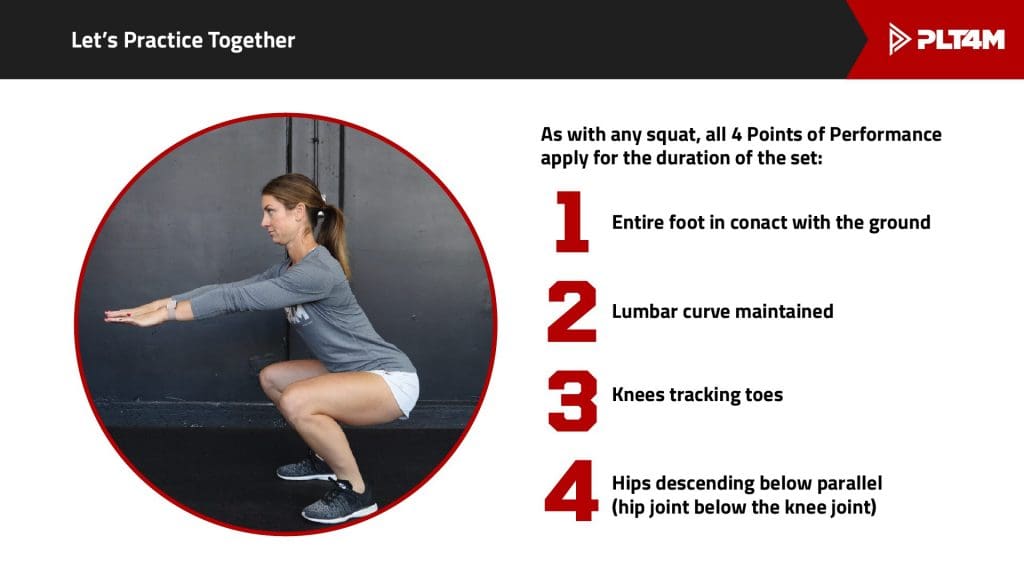
Step 7: Closing Out The Conference
After the full squat breakdown, we wanted to draw people back to major takeaways both from our presentation, but the entire conference. What does this have to do with teaching PE at any school or setting?
The more choices students have to stay physically active for the rest of their lives the better. The best way to help students navigate those choices is through establishing a strong foundation with all of the fundamental human movements.
PE teachers are tasked with being a jack of all trades and teaching students so many different content and topic areas. While they can continue to add things to their arsenal, being solid and strong at teaching the basics can go a long way.
